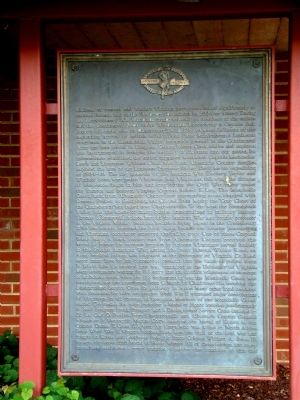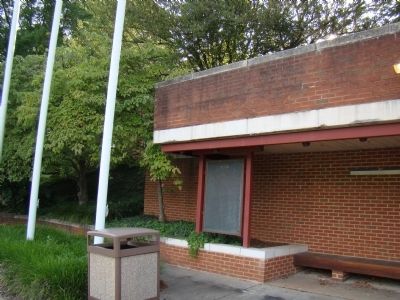Near Charlottesville in Albemarle County, Virginia — The American South (Mid-Atlantic)
Vanguard of Freedom
United States Army
— Bicentennial 1775–1975 —
During the Revolutionary War, Virginians fought valiantly as members of the militia and the Continental Army under Washington. Noteworthy is Captain Jack Jouett’s all-night ride to Charlottesville in 1781 to warn Jefferson of the impending arrival of British cavalry. John Peter Muhlenbert, a Lutheran clergyman in the Shenandoah Valley, became a general in the Continental Army and later served in Congress. George Rogers Clark, soldier and explorer, was instrumental in bringing the territory of six states into our nation. Its independence established, the nation expanded westward. Captain Meriwether Lewis and Lieutenant William Clark, both from Albemarle County families, explored the area of the Louisiana Purchase during their heroic expedition of 1804-06.
The key generals of the Mexican War, Zachary Taylor and Winfield Scott, were native Virginians, and Virginians, following the dictates of conscience, fought in blue and gray during the Civil War, many under the famous and beloved Virginia General Robert E. Lee. The Monticello Guard unit, from Albermarle County and surrounding areas, charged with General Pickett at Gettysburg and Colonel John Mosby, the “Gray Ghost of the Confederacy,” was raised near Charlottesville. To the west, the Shenandoah Valley was the scene of many battles immortalized in military history. Thomas J. “Stonewall” Jackson, hero of the Mexican War and former professor at the Virginia Military Institute, became a living legend in the Confederacy.
With the country reunited, the Army again became the frontier peacekeeper, and Virginians once more answered the call to duty. One of these, Corporal Iasiah Mays, a Black cavalryman from Albemarle County, received the Medal of Honor for extreme heroism in Arizona. Virginians served bravely in the Spanish American War; among the most famous, Walter Reed, an Army medical officer, was educated at the University of Virginia. Dr. Reed saved many lives by his courageous research into the cause of yellow fever.
In World War I, a medical unit was organized at the University of Virginia. Many students, not waiting for U.S. entry into the conflict volunteered as members of ambulance units. After the U.S. declaration of war, the Monticello Guard was reactivated and one guardsman, John O. Marsh of Charlottesville, received the Distinguished Service Cross for gallantry in action. Many other local residents were decorated for valor and service.
World War II witnessed major contributions by Virginians in all theaters of operation. Members of the Monticello Guard earned 134 medals for valor, including a Medal of Honor awarded posthumously to Staff Sergeant Frank Peregory and a Distinguished Service Cross awarded to 2d. Lt. Carl D. Proffitt. From Charlottesville and Albemarle County, General Alexander A. Vandegrift, Marine Corps, received the Medal of Honor, as did Colonel Demas T. Craw, U.S. Army Air Corps, who was killed in North Africa.
Since World War II, Virginia soldiers have kept the vigil of the cold war and fought in Korea and Southeast Asia. Air Force Colonel William A. Jones, III, became the area’s fifth Medal of Honor winner. All of these soldiers, and many more, have established a proud tradition of service that continues to this day.
Erected 1975.
Topics and series. This historical marker is listed in this topic list: Military. In addition, it is included in the Former U.S. Presidents: #12 Zachary Taylor series list. A significant historical year for this entry is 1781.
Location. 38° 0.411′ N, 78° 28.824′ W. Marker is near Charlottesville, Virginia, in Albemarle County. Marker can be reached from College Drive just west of Scottsville Road (Virginia Route 20), on the right when traveling west. Touch for map. Marker is at or near this postal address: 600 College Dr, Charlottesville VA 22902, United States of America. Touch for directions.
Other nearby markers. At least 8 other markers are within walking distance of this marker. These Willow Oaks (within shouting distance of this marker); Meadow Run Grist Mill ca. 1797 (approx. 0.8 miles away); Michie Tavern (approx. 0.9 miles away); Tobacco Barn ca. 1790 (approx. 0.9 miles away); The Sowell House Floor Plan (approx. 0.9 miles away); The Sowell House ca. 1822 (approx. 0.9 miles away); The Open Porch (approx. 0.9 miles away); Piney River Cabin ca. 1790 (approx. 0.9 miles away). Touch for a list and map of all markers in Charlottesville.
More about this marker. Marker is at the former Western Virginia Bicentennial Center, now shuttered, at the entrance and on the grounds of the Piedmont Virginia Community College. At this writing the parking lot and grounds of the visitors center are open.
Credits. This page was last revised on February 2, 2023. It was originally submitted on August 23, 2009, by J. J. Prats of Powell, Ohio. This page has been viewed 1,195 times since then and 31 times this year. Photos: 1, 2. submitted on August 23, 2009, by J. J. Prats of Powell, Ohio.

